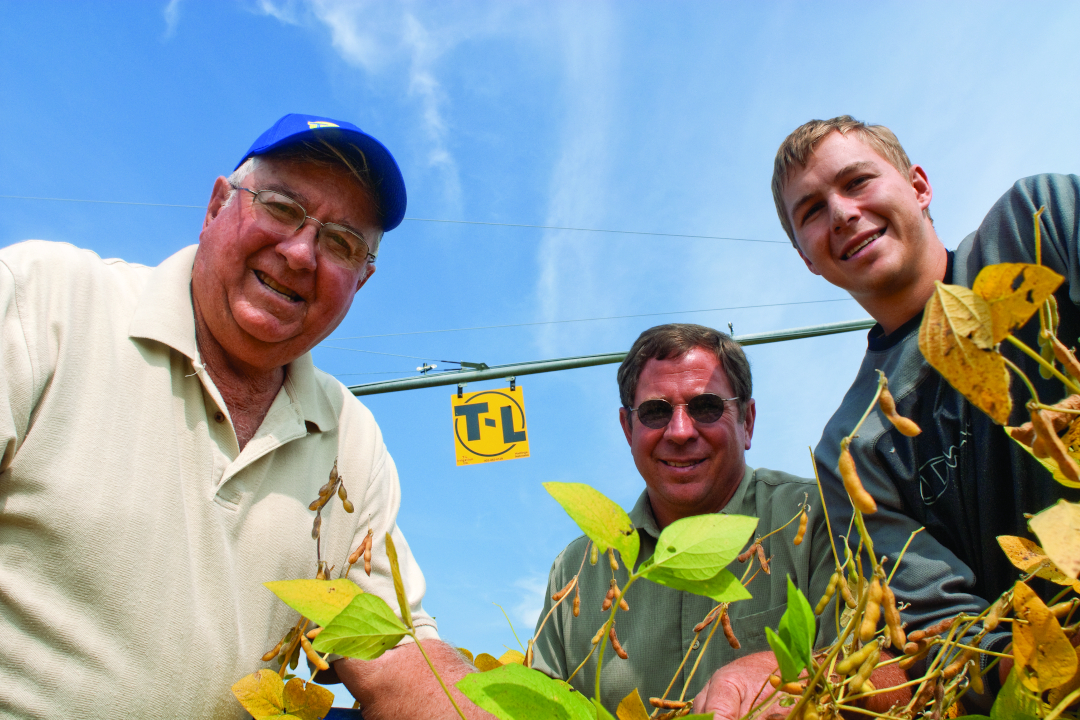Read stories from farmers all around the world and why they chose T-L.
Duane, Russ & Geoff Ochsner
"There’s no doubt about it. Evaporation loss is less with a T-L pivot."
On a farm near Roseland, Nebraska, the Ochsner family’s experience with irrigation began in 1947 using ditch water and siphon tubes. Then, in 1980, two T-L center pivots were placed on their hillier ground by Duane Ochsner. He’s now semi-retired and operates another smaller farm with one T-L.
As he notes, “Irrigating in the ‘40s and ‘50s, before pivots, a lot of land around here was messed up by land leveling that buried the good soil.”
His son, Russ, now operates nine center pivots. Eight of them are hydraulically powered T-Ls and one an electrically powered system that was already on land when he bought it. His corn yields are topping out at 210 to 240 bushels an acre, and his soybeans produce 60 to 70 bushels an acre on land that’s been ridge-tilled since 1978.
“We just have a lot of confidence in our T-Ls,” he stresses, “and have had through the years. My confidence in an electric system is less. Yes, an electric puts water on the ground, too, but….”
“For instance, I drain more condensation from my electric system than from all my T-Ls together.”
“If there’s a problem with a T-L, I can say, ‘Well, I’ll have it running again by 4 p.m.,’” says Russ. “With the electric it’s, ‘Where’s the repair man’s phone number?’ Then it can easily be two or three days before somebody shows up.”
Geoff is Russ’s son, and their fifth generation. He also observes they haven’t worked much on their only electric system since they usually have to call somebody to fix it—and that if he were farming ‘way out somewhere’ that would be an important factor. It’s annual maintenance cost is more than for any of the T-Ls. The electric’s biggest problem has been U-joint and gear box wear from all the starting and stopping it does.
Meanwhile, their T-Ls’ steady, continuous pull doesn’t cause that kind of wear. Another irritation with electric system is that tall corn wraps around its exposed drive shafts.
“There’s also a safety issue that you have to be cautious about,” Russ says.
“An electric pivot system serviceman once told me that whenever I walk up to an electric pivot to always touch the bottom of the control box with the back of my hand and never with my open hand or on its side,” he adds. “That way if there’s a short or something the 480 volts won’t close my grip on it and I should be able to get my hand away.”
“Or, to put it another way”, Duane says, “Water and electricity just don’t go together for me,” he adds. “A farmer usually knows a fair amount about fixing hydraulic things, but electricity’s a different matter.”
Surprisingly, they found another attribute of T-Ls is good resale value, which is something not normally thought of when considering pivots. When they traded off their two original 30-year-old T-Ls for two new T-Ls this year, they were “satisfied with the amount of trade-in value even though they’d run 29 years.”
Comparing center pivot irrigation with gravity irrigation, Russ points out, “There’s no doubt about it. Evaporation loss is less with a T-L pivot.”
He also notes that on comparable fields watering time with a pivot is two days versus all week with gravity. That has special importance when it’s extremely hot and the crop is at a critical stage.
His experience also shows that, on the same quarter section of ground, gravity irrigation would require a 1,500 to 2,000 gallon per minute well. A center pivot system does the same watering job with only 800 to 900 gallons per minute.
“What if you need to water up a crop or have dry ground that’s blowing away?” Duane asks. His answer in either case is to “Run the pivot, and pretty fast, too, especially if the soil is blowing.”
“How important is irrigation around here?” he continues. “Recently, for four years in a row, a lot of the acres wouldn’t have grown anything without irrigation.”

- Products
- Center Pivot
- Crops
- Corn
- States
- Nebraska
- Countries
- United States


